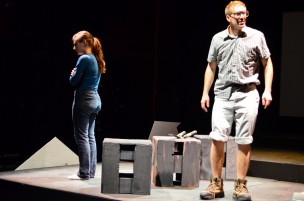
Dan Goldman/Staff Photograher
The past week at Wesleyan has been a scary one, and not just because of Halloween and hurricanes. If you were in the mood for something to send shivers down your spine and wrench your gut, you didn’t need to look any further than “Neighborhood 3: Requisition of Doom,” an incredible play by Jennifer Haley flawlessly presented by directors Gabe Gordon ’15 and Emilie Pass ’15 last week in the ’92 Theater.
Part zombie horror story, part family drama and beautifully crafted suspense thriller, “Neighborhood 3” is Haley’s 2008 keystone work. Haley’s oeuvre also includes environmental activism, memory, and the many common difficulties of life in the 21st century. Its plot centers on a video game that is popular among the children of a suburban housing development: a survival horror game that maps their own neighborhood using GPS technology and creates it anew in the game, this time infested with zombies. Cruelty is normal. Brutality is encouraged. And some of the zombies look shockingly like people from the neighborhood…as the worlds of the game and reality begin to collide, horrors become manifest, and none more so than those that might be lurking just behind a door in the characters’ own homes.
Using only four incredible actors who play a variety of characters, “Neighborhood 3” is tautly written, coming in at just over 70 minutes. Playing the older men (credited as “Father Type” in the program) was Noah Masur ’15, who bounced ably from a father who is concerned for his daughter’s strange behavior to a bizarre neighbor who insists on whacking his weeds each day. Tess Jonas ’15 played the “Mother Type,” riding the knife-edge of hysteria at several points but also hitting beautiful moments of calm and concern, particularly in a scene between a mother and her son Blake.
Mark Popinchalk ’13 and Eva Ravenal ’15 were beautiful as the teenage characters (“Son Type” and “Daughter Type”), pulling us in from the very first moments. Popinchalk adeptly covered perhaps the widest spectrum of humanity, from the struggling son of an alcoholic judge to the pitiless video game avatar of a player; these performances were some of the most striking, a staggering array of characters united by a vulnerability and insecurity that was to various degrees hidden or exposed. Ravenal also displayed incredible range, from teenage flirt to goody two-shoes and, finally, a remarkably nuanced Goth rebel.
Rounding out this exceptional ensemble was Leah Khambata ’14, whose voice provided a series of pitch-perfect interludes that walked players through the game. Frequently these interludes described areas appearing or vanishing in reality, and tableaus of the characters’ shadows appeared in a projection of rippling color, giving us one more hint of the violence that is so often implied, but rarely seen, in the play.
The actors’ brilliant performances were well served by the work of scenic designer Cara Sunberg ’15 and lighting designer Rachel Leicher ’15. Brilliant in its simplicity, the set consisted of a series of platforms leading up to the ’92 stage and flanked by a series of flat, cut-out houses. At the bottom of the set was a modest house, and the platforms ascended to an imposing edifice that also provided the screen on which the shadow tableaus were thrown. Much of the game—and horror—centered on what lay in the “Final House,” and as the tension built directors Gordon and Pass moved the action up the platforms toward the stage. The device was simple, but effective. Leicher’s lighting design was alternately lush and stark, pulling us between the world of super-reality and the more familiar horrors of our own world with ease and beauty.
In a realm of its own, though, was the sound design, which included original music (both of which are credited to Gabe Beaudoin ’15 and Eriq Robinson ’15). Providing ambient sounds, incidental sounds (video game jingles that played whenever certain code words were mentioned), and interlude music, the soundscape of the play was a pulse-pounding and evocative addition to the horror going on onstage.
“It really is a play about family relationships,” Pass said when asked about the directors’ reasons for directing the play. “Even though the language is really youth-oriented, the script also has these moments of real lyricism that I found really attractive.”
“I don’t see this as a cautionary tale of what happens if you play too many video games,” Gordon said. “The story is through the vehicle of the video game, something that people can relate to, to show what’s real and what’s not real and what we create in our heads and how we’re affected by the people around us; I think that’s what Jennifer Haley is really writing about.”
“It’s more a play about addiction being a negative thing than a play that’s anti-videogames,” Pass added.
Despite that assurance, it’s difficult at times not to detect a rather conservative mindset in “Neighborhood 3,” given its critique of video game violence and apparent despair over the state of the modern family (was there a single untroubled relationship in the play?). But this was easily forgotten in the breathtaking suspense of the show. It was a gripping spectacle, and one that lay bare in stark terms the bleakest horrors: the horrors in our computers, in our bedrooms, and perhaps within and between ourselves.
Assistant Arts Editor Gwen Rosen contributed reporting for this article.
Comments are closed